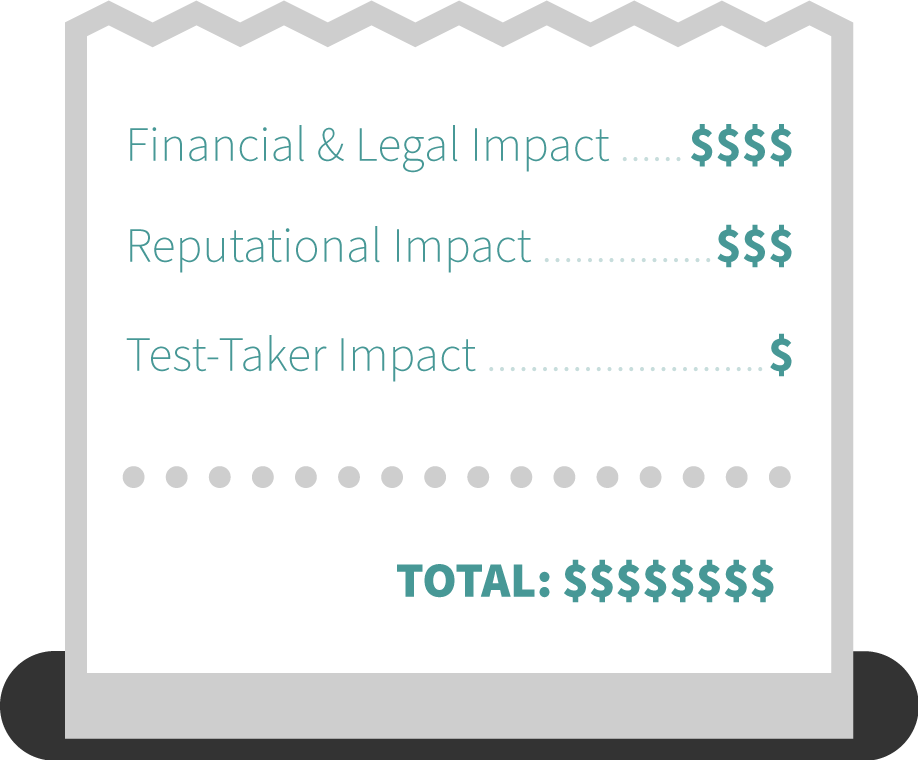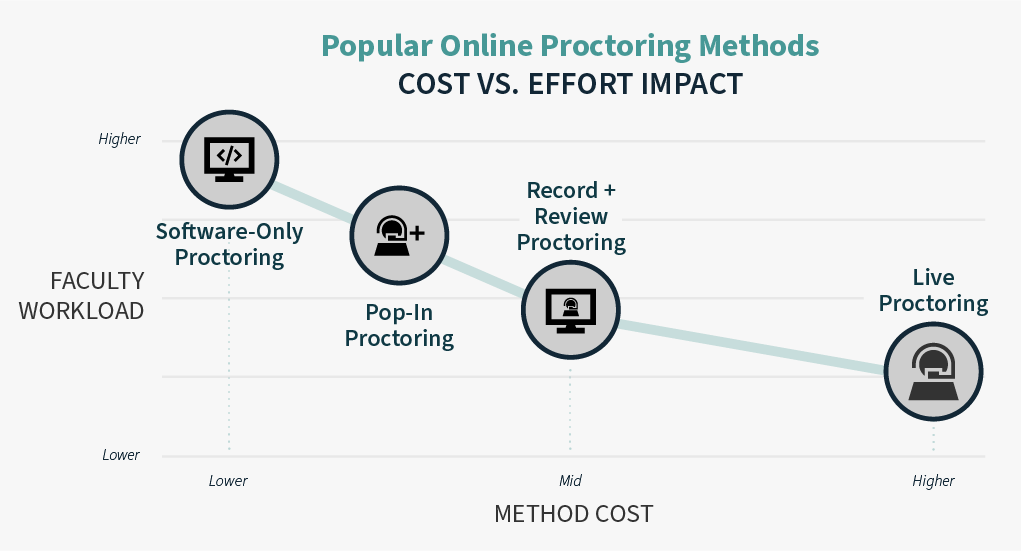(This article has been updated from its original version, published in January 2023.)
Did you know that 50% to 70% of college students admit to academic cheating? With misconduct on the rise and easier access to generative AI tools, universities and other academic institutions must consider their options for online proctoring carefully. After all, proctoring has proven to be an effective method for mitigating dishonest behavior: Research shows that 70% of students cheat during unproctored exams but only 15% do so during proctored exams.
Budget is always a concern when weighing proctoring options, but it’s important to ask what you’re getting for the cost—and more importantly, what you might be losing. Fully automated or pop-in proctoring solutions may come with a cheaper price tag, but they often result in a larger institutional workload because they lack the security, flexibility, and accessibility needed for online proctoring to be effective. And when an online proctoring solution is ineffective? Cheating goes undeterred and undetected, leading to a series of negative ripple effects.
Institutional Costs Associated With Ineffective Online Exam Proctoring
When a proctoring solution does not work as well as it should, cheating tends to spread like a virus. We’ve seen firsthand what can happen, with headline-making stories from the Naval Academy, Cal State LA, Harvard, and more. The negative effects can become quite serious, ranging from legal and financial costs to reputational and test-taker harm. Here are just a few of those repercussions:
Financial and legal impacts
- Loss of accreditation
- Loss of state or federal funding
- Potential lawsuits from test-takers accused of cheating
- Resources needed to replace stolen exam questions
- Time and money spent investigating integrity incidents
Reputational consequences
- Decreased enrollment in program or institution
- Negative perception of program’s validity for employment
- Unfavorable media coverage
Test-taker harm
- Loss of degree value if the institution loses its accreditation
- Loss of program for test-takers who are currently enrolled
- Suspension, expulsion, or a black mark on their record
- Negative behavioral impacts such as habit-forming patterns or dishonesty acceptance

The costs of online exam proctoring are interconnected, very real, and very expensive, either in time, money, or reputation. It is possible to protect academic integrity without spending more, but a fully automated or pop-in proctoring solution isn’t the answer. It can cost far more than it saves.
Why Do “Low-Cost” Online Exam Proctoring Solutions Fail to Address Test Cheating?
Most low-cost proctoring solutions rely solely on software to monitor online exam sessions. In a fully automated proctoring solution, the platform uses algorithms or AI to flag and report suspicious behavior without human oversight into how accurate those flags may be. Even pop-in proctoring methods, where a proctor “pops in” to exam sessions at random and for unknown amounts of time, rely almost entirely on software. In fact, our proprietary research shows that pop-in proctors only “pop in” to 2.5% of the exams they’re responsible for monitoring. These methods allow proctoring providers to keep their costs low by hiring fewer proctors.
Many “low-cost” proctoring solutions have emerged in recent years claiming to effectively use only software to flag cheating behavior. That claim is simply false. Here are a few reasons why.
Fully Automated Solutions Rely Exclusively on Computer Algorithms or AI, Leading to False Negatives and False Positives
Recently, researchers at a Netherlands university have scientifically proven the ineffectiveness of these systems. Their study found that no students who were instructed to cheat on an exam were flagged by a fully automated proctoring system. Not a single student. Furthermore, several students who did not cheat were flagged for suspicious behavior. This led to a high percentage of false negatives and “disastrous” system sensitivity.
False negatives in software-only solutions occur because a machine can’t distinguish between suspicious behavior and unexpected behavior. For example, a student using a screen reader to take an exam may not look at the computer screen. AI might flag this behavior as potential cheating, rather than an accessibility accommodation
If Your Proctoring Vendor Isn’t Reviewing Sessions, That Burden Falls on Institutional Resources

To combat negative impacts, some fully automated proctoring providers offer “add-on” services that require an additional fee for human review. It’s a little like booking a plane ticket with a “no frills” airline. While the base cost of the ticket itself appears inexpensive, baggage, seat assignments, upgrades, snacks, and even water cost extra.
Similarly, fully automated solutions offer the bare minimum for an affordable cost but charge extra for higher security or professional supervision. Because of this, your institution may ultimately either pay more money for proctoring or lose precious time and resources requiring their instructors and professors to perform a human review instead. Properly reviewing sessions takes a lot of time that faculty and administrators often don’t have. How much time? Even Meazure Learning’s trained, professional proctors have to spend an average of 47 minutes reviewing each session. To review 100 exams, institutional staff would spend 4,700 minutes—or 78 hours! Even worse, research from the Higher Education Policy Institute shows that academic staff spend 93.3 hours investigating suspected misconduct per 100 exams, while administrative staff spend 176.4 hours.
It makes you wonder: Are the initial savings of a “low-cost” solution worth the strain on institutional time, effort, and morale?
“The human cost of low-cost proctoring solutions can vastly outweigh the savings, especially if the burden of review falls on institutional staff, increasing their workload and consuming valuable time.”
Without Human Review and Validation, Your Exam Is Vulnerable to Cheating and Security Threats
Software-only solutions ultimately fail for one reason: Even the most advanced AI is currently no replacement for human eyes and a critical brain. Adding an element of human review to your exam process is invaluable to the success and reputation of your exam. Given AI’s poor track record of identifying cheating as it happens, a human proctor’s analysis can provide a level of security that fully automated or pop-in proctoring systems cannot.
In addition to falsely flagging test-taker behavior and missing signs of actual cheating, these systems leave your exam open to a plethora of security concerns. Human proctors who monitor every minute of every exams can spot test-taker signs of misconduct. While no exam system is completely free of attempted cheating, adding a human proctor can prevent many instances—sometimes by their mere presence—filling integrity gaps that software alone cannot. Given that recent research shows the staggering financial toll of exam misconduct on institutions, with costs reaching $121,500 spent per 1,000 cases, reinforcing your proctoring method with human oversight is essential.
The Bottom Line on Low-Cost Proctoring
Low-cost proctoring solutions, including fully automated and pop-in methods, have numerous hidden costs, and preventing those costs has never been more important to safeguarding your institution and academic integrity. While these solutions are priced attractively upfront, the costs associated with using them are innumerable. Perhaps AI will catch up someday, but for now, human monitoring is the only way to effectively protect against devaluation.
To explore practical steps for preventing cheating without additional costs, check out our article 8 No-Cost Ways to Mitigate Academic Misconduct in Higher Education.